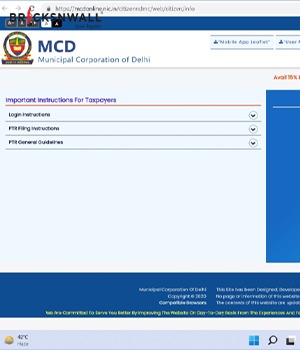Understanding Infrastructure Development Charges (IDC): What Home Buyers Should Know
Bricksnwall Trusted Experts

Infrastructure Development Charges (IDCs) are an
important component of urban planning and real estate development. So, what
precisely is it? Why is this so important? And how does this affect the real
estate market?
Infrastructure Development Charge is an important tool for promoting long-term urban development. Understanding its components, benefits, and challenges can help stakeholders manage the intricacies of real estate development and urban planning.
Let's go in and investigate these questions
What is the Infrastructure Development Charge (IDC)?
IDC is a tax charged by local governments or
municipalities to developers to build infrastructure for new developments. This
includes roads, water supply, sewage systems, and other public services
required to support a growing population.
Importance of Infrastructure Development Charge
IDC is critical to ensuring that urban infrastructure keeps up with population expansion. Without it, communities may face overloaded roadways, insufficient water supplies, and other difficulties that might impede quality of life and economic development.
How does IDC effect real estate development?
The charge has a direct impact on the cost of
development projects. While it increases the initial costs for developers, it
also assures that the essential infrastructure is in place, ultimately
benefiting both residents and developers by establishing a well-serviced
community.
Historical Context for Infrastructure Development
Charges
Looking back on the past might help you comprehend
the present. IDC has evolved in response to a variety of economic, political,
and social issues.
Origins of Infrastructure Development Charges
The idea of charging developers for infrastructure is not new. It dates back to ancient civilisations, when communities pooled resources to construct roads and aqueducts.
Evolution over time
Over the ages, the systems for collecting and
utilising these charges have advanced. Rapid urbanisation during the twentieth
century resulted in IDC being a widespread practice in several nations.
Components of Infrastructure Development Charge
IDC is more than simply one fee; it is made up of
various components.
Land Acquisition Costs
One substantial element of IDC funds the
acquisition of land for public infrastructure such as roads and parks.
Construction Costs
A significant portion of the charge goes towards
infrastructure development, which includes everything from road construction to
sewage system installation.
Maintenance and upkeep costs
IDC also handles the long-term maintenance and
upkeep of the infrastructure, ensuring that it stays operational and safe.
Administrative and Regulatory Costs
A portion of the fee goes towards administrative
costs associated with planning, regulation, and compliance monitoring.
Calculating Infrastructure Development Charges
How are these charges computed? It is a complicated
process influenced by a variety of elements.
Factors affecting IDC calculation
The size and type of development, location, and projected population growth are all important considerations.
Methods of calculation
Different regions use different methods to
calculate IDC. Some charge a fixed rate per square metre, while others may take
a more flexible approach based on the unique project requirements.
Examples of IDC calculations:
For example, a residential project in a
metropolitan region may have a greater IDC than a rural development due to
increased infrastructure demands.
Legal and Regulatory Framework
IDC is governed by a collection of laws and regulations that differ between countries and regions.
National and Local Regulations
National standards establish a framework, while
local regulations frequently control the specifics of IDC collection and use.
Compliance requirements
Developers must follow these regulations, which may
include comprehensive reporting and adherence to construction standards.
Impact of Noncompliance
Failure to comply can result in significant fines,
project delays, or even the cancellation of development approvals.
Benefits of the Infrastructure Development Charge
While it may appear to be an additional expenditure
for developers, it actually provides various benefits.
Improved infrastructure quality.
The key benefit is higher-quality infrastructure, which can greatly improve living conditions in developing countries.
Enhanced Property Values
Well-developed infrastructure frequently leads to
increasing property values, benefiting both developers and property owners.
Economic Growth Stimulus
IDC can support economic growth by luring
businesses and making processes more efficient.
Challenges and Criticism
However, IDC is not without flaws and complaints.
High costs for developers
One of the biggest critiques is the expensive cost,
which might be prohibitive for smaller developers.
Potential for Corruption
There is also a risk of corruption and
mismanagement of finances, particularly in regions with less open governance.
Disparities in the Charge Application
Inconsistent use of IDC can result in inequities, with some areas receiving more infrastructure investment than others.
IDC and Sustainable Development
IDC can also help promote sustainable development.
Promoting green infrastructure
By allocating funds for green infrastructure, IDC
can contribute to the development of environmentally pleasant and sustainable
communities.
Integrating IDC and Sustainable Practices
Developers can combine IDC with other measures like
as rainwater harvesting and renewable energy systems.
Long-term Environmental Benefits
These sustainable measures improve the environment
while also lowering long-term costs and increasing property values.
The Role of IDC in Urban Planning
IDC is an important instrument in urban planning,
supporting planned and balanced urban expansion.
facilitating planned urban growth
It assists urban planners in ensuring that new developments receive adequate infrastructure support.
Balancing Development and Infrastructure Needs
IDC enables a balanced approach by ensuring that
development does not outstrip infrastructure, resulting in a more sustainable
urban environment.
Examples of Successful Urban Planning Using IDC
Cities such as Singapore have effectively
implemented IDC to build well-planned, modern urban environments.
Case Studies for Infrastructure Development Charge
Implementation
Examining case studies provides practical insights
into the use and impact of IDC.
Successful IDC Implementation in Singapore
Singapore's efficient use of IDC has been critical
to its quick development and high standard of living.
Challenges of IDC Application in India
In contrast, India confronts problems such as regulatory barriers and inconsistent application, which reduce the effectiveness of IDC.
Future Trends in Infrastructure Development Costs
IDC's landscape is always altering as new trends
and technology emerge.
Increasing Focus on Smart Cities
There is an increasing emphasis on smart city
programs, which combine technology and IDC to create more efficient urban
environments.
Technology Advances in IDC Calculation
Technological advancements are increasing the
accuracy and transparency of IDC estimations.
Potential Changes in Regulatory Policies
Future legislation may seek to make IDC more
responsive to shifting urban requirements and environmental concerns.
Summary of Key Points:
IDC funds key infrastructure, which promotes
sustainable development and plays an important role in urban planning. While it
creates hurdles, the advantages greatly exceed the disadvantages.
Future of Infrastructure Development Charges
As cities expand, IDC will change, including more ecological methods and advanced technologies to satisfy the demands of modern urban life.







